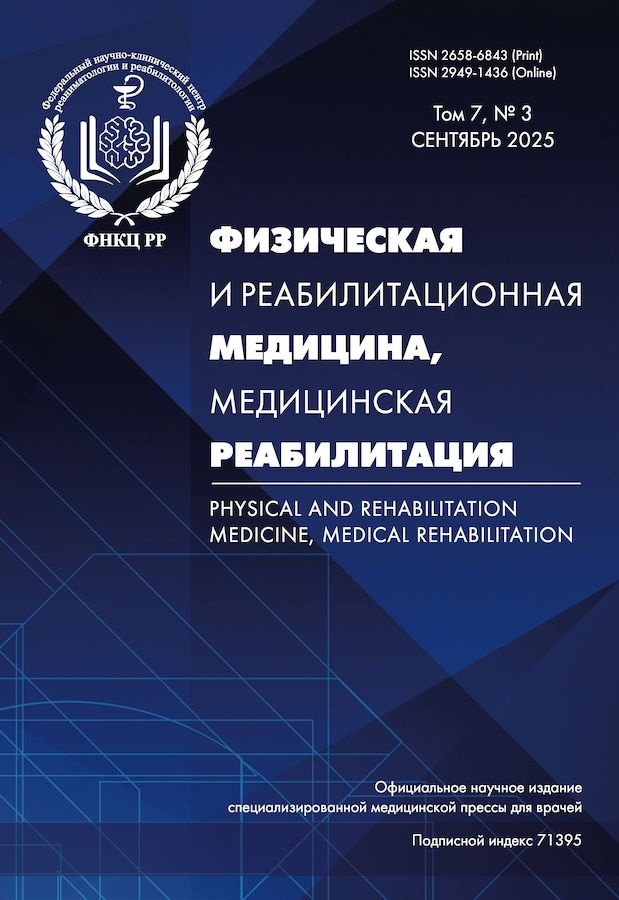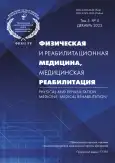Biomarkers — predictors of mortality in patients with ischemic stroke
- Authors: Golubev A.M.1,2, Radutnaya M.L.1, Zakharchenko V.E.1, Babkina A.S.1, Petrova M.V.1,2, Lyubomudrov M.A.1, Yadgarov M.Y.1, Bondar E.L.1, Parfenov A.L.1, Grechko A.V.1,2
-
Affiliations:
- Federal Research and Clinical Center of Intensive Care Medicine and Rehabilitology
- Peoples’ Friendship University of Russia
- Issue: Vol 5, No 4 (2023)
- Pages: 312-321
- Section: ORIGINAL STUDY ARTICLE
- URL: https://bakhtiniada.ru/2658-6843/article/view/249999
- DOI: https://doi.org/10.36425/rehab619331
- ID: 249999
Cite item
Full Text
Abstract
BACKGROUND: Stroke is a global health problem and the second leading cause of death worldwide, with ischemic stroke accounting for the majority of acute cerebrovascular accidents. Predicting outcomes in patients with ischemic stroke is challenging due to the limited prognostic performance of existing models. The lack of reliable and predictive biomarkers of ischemic stroke used in clinical practice provides a rationale for studies to address this issue.
AIM: The aim of this study was to identify clinical, demographic, neuroimaging and molecular biomarkers of ischemic stroke associated with the fatal outcome of the disease.
MATERIALS AND METHODS: We retrospectively analyzed cases of ischemic stroke confirmed by computed tomography of the brain with a duration of 3 months or less. As factors potentially related to the outcome of ischemic stroke, we considered (1) clinical and demographic characteristics, including sex, age, history of acute cerebrovascular accident, time from stroke to hospitalization, phase and type of stroke, neurological status on admission (level of consciousness, FOUR coma scale), comorbidities (diabetes mellitus, infectious complications, oncological diseases); (2) molecular biomarkers including blood glucose and neuron-specific enolase (NSE) levels at different phases of stroke; (3) neuroimaging biomarkers such as number and location of stroke lesion, total infarct volume, signs of edema, hemorrhagic component according to computed tomography.
RESULTS: 38 patients with ischemic stroke were included in the study. Lesion volume was larger in non-survivors: 123 [44.6–206.2] versus 42.7 [8.2–88.7] ml3 (p=0.032), and cerebral edema was detected significantly more often on admission CT scan than in survivors: 7 (77.8%) versus 10 (34.5%), p=0.022. Stroke lesion volume was a predictor of mortality (AUC 0.739; 95% CI 0.542–0.937; p=0.032). The optimal cut-off for stroke lesion volume was found to be 90 ml3.
CONCLUSION: Signs of edema/brain stem dislocation and cerebral lesion volume >90 ml3 documented at hospital admission are predictors of fatal outcome. Therefore, neuroimaging biomarkers can be used for risk stratification of fatal outcome in ischemic stroke patients.
Full Text
##article.viewOnOriginalSite##About the authors
Arkady M. Golubev
Federal Research and Clinical Center of Intensive Care Medicine and Rehabilitology; Peoples’ Friendship University of Russia
Author for correspondence.
Email: arkadygolubev@mail.ru
ORCID iD: 0000-0002-3165-0378
SPIN-code: 7890-2597
MD, Dr. Sci. (Med.), Professor
Russian Federation, 25/2 Petrovka street, 107031 Moscow; MoscowMargarita L. Radutnaya
Federal Research and Clinical Center of Intensive Care Medicine and Rehabilitology
Email: mradutnaya@fnkcrr.ru
ORCID iD: 0000-0002-9181-2295
SPIN-code: 1077-5970
Russian Federation, 25/2 Petrovka street, 107031 Moscow
Vladislav E. Zakharchenko
Federal Research and Clinical Center of Intensive Care Medicine and Rehabilitology
Email: kdl-fnccrr@yandex.ru
ORCID iD: 0000-0003-4873-8007
SPIN-code: 1481-5666
Russian Federation, 25/2 Petrovka street, 107031 Moscow
Anastasiya S. Babkina
Federal Research and Clinical Center of Intensive Care Medicine and Rehabilitology
Email: asbabkina@gmail.com
ORCID iD: 0000-0003-1780-9829
SPIN-code: 2918-0460
MD, Cand. Sci. (Med.)
Russian Federation, 25/2 Petrovka street, 107031 MoscowMarina V. Petrova
Federal Research and Clinical Center of Intensive Care Medicine and Rehabilitology; Peoples’ Friendship University of Russia
Email: mpetrova@fnkcrr.ru
ORCID iD: 0000-0003-4272-0957
SPIN-code: 9132-4190
MD, Dr. Sci. (Med.), Professor
Russian Federation, 25/2 Petrovka street, 107031 Moscow; MoscowMaksim A. Lyubomudrov
Federal Research and Clinical Center of Intensive Care Medicine and Rehabilitology
Email: mlyubomudrov@fnkcrr.ru
ORCID iD: 0000-0002-1735-592X
SPIN-code: 4022-5096
Russian Federation, 25/2 Petrovka street, 107031 Moscow
Mikhail Ya. Yadgarov
Federal Research and Clinical Center of Intensive Care Medicine and Rehabilitology
Email: mikhail.yadgarov@mail.ru
ORCID iD: 0000-0003-3792-1682
SPIN-code: 9654-6750
MD, Cand. Sci. (Med.)
Russian Federation, 25/2 Petrovka street, 107031 MoscowEkaterina L. Bondar
Federal Research and Clinical Center of Intensive Care Medicine and Rehabilitology
Email: bondar@fnkcrr.ru
ORCID iD: 0000-0001-8641-9846
SPIN-code: 3727-2250
Russian Federation, 25/2 Petrovka street, 107031 Moscow
Alexander L. Parfenov
Federal Research and Clinical Center of Intensive Care Medicine and Rehabilitology
Email: aparfenov@fnkcrr.ru
ORCID iD: 0000-0002-5012-0516
SPIN-code: 5952-1959
MD, Cand. Sci. (Med.)
Russian Federation, 25/2 Petrovka street, 107031 MoscowAndrey V. Grechko
Federal Research and Clinical Center of Intensive Care Medicine and Rehabilitology; Peoples’ Friendship University of Russia
Email: avgrechko@fnkcrr.ru
ORCID iD: 0000-0003-3318-796X
SPIN-code: 4865-8723
MD, Dr. Sci. (Med.), Professor, Corresponding Member of the RAS
Russian Federation, 25/2 Petrovka street, 107031 Moscow; MoscowReferences
- Feigin VL, Stark BA, Johnson CO, et al. Global, regional, and national burden of stroke and its risk factors, 1990–2019: A systematic analysis for the Global Burden of Disease Study 2019. Lancet Neurol. 2021;20(10):795–820. doi: 10.1016/S1474-4422(21)00252-0
- ElAli A, LeBlanc JN. The role of monocytes in ischemic stroke pathobiology: New avenues to explore. Front Aging Neurosci. 2016;(8):29. doi: 10.3389/fnagi.2016.00029
- Montellano FA, Ungethüm K, Ramiro L, et al. Role of blood-based biomarkers in ischemic stroke prognosis: A systematic review. Stroke. 2021;52(2):543–551. doi: 10.1161/STROKEAHA.120.029232
- Atkinson AJ, Colburn WA, DeGruttola AG, et al. Biomarkers and surrogate endpoints: preferred definitions and conceptual framework. Clin Pharmacol Ther. 2001;69(3):89–95. doi: 10.1067/mcp.2001.113989
- Jickling GC, Sharp FR. Blood biomarkers of ischemic stroke. Neurotherapeutics. 2011;8(3):349–360. doi: 10.1007/s13311-011-0050-4
- Kamtchum-Tatuene J, Jickling GC. Blood biomarkers for stroke diagnosis and management. Neuromolecular Med. 2019;21(4): 344–368. doi: 10.1007/s12017-019-08530-0
- Kawata K, Liu CY, Merkel SF, et al. Blood biomarkers for brain injury: What are we measuring? Neurosci Biobehav Rev. 2016;(68):460–473. doi: 10.1016/j.neubiorev.2016.05.009
- Montaner J, Ramiro L, Simats A, et al. Multilevel omics for the discovery of biomarkers and therapeutic targets for stroke. Nat Rev Neurol. 2020;16(5):247–264. doi: 10.1038/s41582-020-0350-6
- Golubev AM, Grechko AV, Zakharchenko VE, et al. Comparative characterisation of the content of candidate molecular markers in ischemic and hemorrhagic stroke. General Intensive Care Med. 2021;17(5):23–34. doi: 10.15360/1813-9779-2021-5-23-34
- Bernhardt J, Hayward K, Kwakkel G, et al. Agreed definitions and a shared vision for new standards in stroke recovery research: The stroke recovery and rehabilitation roundtable taskforce. Int J Stroke. 2017;12(5):444–450. doi: 10.1177/1747493017711816
- Patent RUS 2533968 C1. Shchedrenok VV, Zakhmatov IG, Moguchaya OV, et al. Method for determining the volume of intracerebral mass. (In Russ). Available from: https://yandex.ru/patents/doc/RU2533968C1_20141127?ysclid=lp3wl9pda049909988. Accessed: 15.11.2023.
- Wang J, Yu XD, Li GQ. Comparative study on short-term and long-term prognostic determinants in patients with acute cerebral infarction. Int J Clin Exp Med. 2015;8(6):9855–9861.
- Meng X, Ji J. Infarct volume and outcome of cerebral ischaemia, a systematic review and meta-analysis. Int J Clin Pract. 2021;75(11):e14773. doi: 10.1111/ijcp.14773
- Du X, Liu Q, Li Q, et al. Prognostic value of cerebral infarction coefficient in patients with massive cerebral infarction. Clin Neurol Neurosurg. 2020;(196):106009. doi: 10.1016/j.clineuro.2020.106009
- Laredo C, Zhao Y, Rudilosso S, et al. Prognostic significance of infarct size and location: The case of insular stroke. Sci Rep. 2018;8(1):9498. doi: 10.1038/s41598-018-27883-3
- Kurakina АS, Semenova TN, Guzanova EV, et al. Prognostic value of investigating neuron-specific enolase in patients with ischemic stroke. Sovrem Tekhnologii Med. 2021;13(2):68–72. doi: 10.17691/stm2021.13.2.08
- Kawle AP, Nayak AR, Lande NH, et al. Comparative evaluation of risk factors, outcome and biomarker levels in young and old acute ischemic stroke patients. Ann Neurosci. 2015;22(2):70–77. doi: 10.5214/ans.0972.7531.220204
- Bharosay A, Bharosay VV, Saxena K, Varma M. Role of brain biomarker in predicting clinical outcome in hypertensive cerebrovascular ischemic stroke. Indian J Clin Biochem. 2018;33(2): 178–183. doi: 10.1007/s12291-017-0664-3
- Huţanu A, Iancu M, Bălaşa R, et al. Predicting functional outcome of ischemic stroke patients in Romania based on plasma CRP, sTNFR-1, D-Dimers, NGAL and NSE measured using a biochip array. Acta Pharmacol Sin. 2018;39(7):1228–1236. doi: 10.1038/aps.2018.26
- Anand N, Stead LG. Neuron-specific enolase as a marker for acute ischemic stroke: A systematic review. Cerebrovasc Dis. 2005;20(4):213–219. doi: 10.1159/000087701
- Ostrova IV, Babkina AS, Lyubomudrov MA, et al. Photochemically induced thrombosis as a model of ischemic stroke. General Reanimatology. 2023;19(3):54–65. doi: 10.15360/1813-9779-2023-3-54-65
- Golubev AM. Personalized critical care medicine (review). General Reanimatology. 2022;18(4):45–54. doi: 10.15360/1813-9779-2022-4-45-54
- Babkina AS, Golubev AM, Ostrov IV, et al. Brain morphological changes in COVID-19. General Reanimatology. 2021;17(3):4–15. doi: 10.15360/1813-9779-2021-3-1-0
Supplementary files









